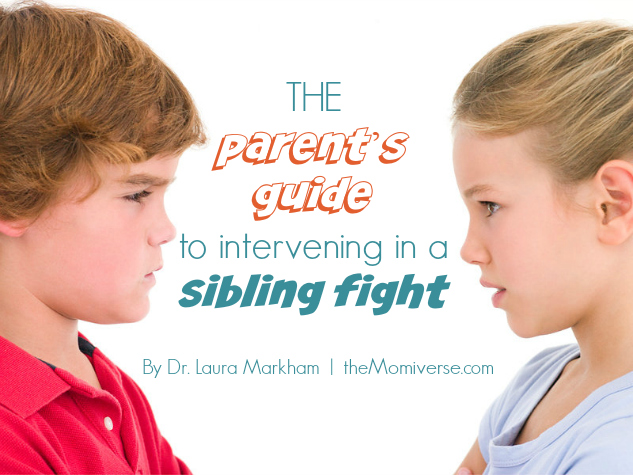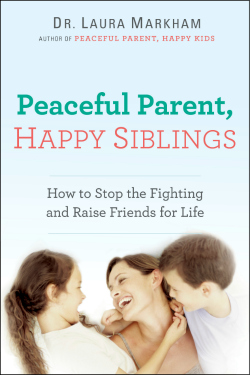
Your children are fighting. Should you step in?
Common wisdom says no, let the kids work it out themselves. That’s because when the parent decides who’s right and tells the children how to resolve the issue, it heightens sibling rivalry. The “loser” resents his parent siding with the other child, and is more likely to initiate another fight, creating a cycle of resentment. Indeed, many studies have confirmed this, showing that when parents stay out of children’s fights, children indeed fight less.
Recent research has added some new wrinkles to our understanding. It turns out that siblings fight less without parental intervention because the more powerful sibling—usually the oldest—gets his way. The other child simply acquiesces. In fact, when we leave kids to work it out themselves, we may be encouraging bullying. In some studies, the presence of an adult within earshot who didn’t intervene was associated with increased rates of aggression between the children, even when that adult pretended to be completely oblivious to the children’s fight.i Apparently, as one researcher observed, “Children…understand non-intervention as an implicit endorsement of their behavior, which may lead to more frequent or more aggressive conflict.”ii
So are we stuck between intervening, which encourages more fights, or not intervening, which encourages bullying? Luckily, no. Research shows there are ways to intervene that actually diminish both sibling rivalry and sibling fights.
Here’s your guide to intervening in a sibling fight:
1. Get between your kids to separate them and prevent further violence.
“Whoa! Stop!” Hold out your hand at chest level or put your hand on the child’s belly to keep him from advancing.
2. Help both kids feel safer so they can stop attacking.
Breathe deeply and use a calm voice. Touch each child so they feel connected.
3. If a child is hurt, comfort that child.
Administer comfort, bandage, ice, empathy. If the child is hurt too badly for you to even be nice to the aggressor, take the wounded child into the bathroom or another room, so you aren’t tempted to shout at the other child. If you can matter-of-factly involve the aggressor (“Ooh, this must hurt. Quick, Joshua, get the ice pack!”), you’ll help him shift from “bad kid who hurt his sibling” to “helpful kid who repairs his mistakes and helps heal his sibling.” That’s an invaluable shift if you want to prevent more hitting in the future.
4. Depending on how upset the kids are, you may want to separate them for a cooling off period.
But don’t send them to their rooms, which will make them feel less safe. Your goal is to teach them some self-calming techniques so they can learn to shift out of an upset state and re-regulate themselves when life doesn’t go their way. Say “I see how mad you both are. I want to hear what’s upsetting you. Let’s cool off for a few minutes so we can talk. Joshua, please sit on the couch. Michael, please come sit on this chair. Now, let’s take three deep breaths together….Breathe deep….Now blow out all those angries. Again.”
5. Bring the children together.
Put an arm around each so when you listen to the one who’s talking, the other still feels connected to you.
6. Give each child a chance to speak and reflect back what you heard.
Use your skills to listen, empathize and interpret.
“Joshua, you hit him because he broke your fire truck ladder?…You were so upset!”
“Michael, you didn’t mean to break it?…You just wanted to see it?”
7. Restate family rules.
“No hitting! Hitting hurts.”
8. Resist siding with either child, even when you think one is clearly right.
Really. Even if one was hurt. Your child knows that hurting his sibling was wrong, and you’ve just re-stated it.
9. Coach each child to tell the other how she feels or what she wants.
“Can you tell your brother ‘Don’t hit me!’?”
“Can you tell your brother that when he wants to use your fire truck, he needs to ask you?”
10. If one child attacks the other, redirect him to express how he feels, not what he thinks of the other child.
“You Stupidhead, Michael!”
“Joshua, tell your brother what you want and how you feel—not what you think about him right now.”
“I want you to ask before you take my truck! Now the ladder is broken! I feel sad!”
11. Coach each child to restate how the other one feels.
“What did you hear your brother say?”
12. Raise the possibility of repair.
“You both got pretty upset. Brothers are for loving, not for hurting. What could you do to make things better?”
When there’s still a problem to be solved, coach kids to use their problem-solving skills.
1. Validate how big the problem feels to your children.
“Joshua’s fire truck is broken. This is a tough problem.”
2. Express confidence that the problem can be solved fairly.
“I know you two can work this out.”
3. Help the children brainstorm a mutually agreeable solution.
Ask each child to write down their suggestions until they compromise on an idea they can both live with.
4. State the solution.
“Okay, so Michael agrees that he will help Joshua tape the ladder with duct tape to see if it can be fixed. And also Michael will let Joshua use his dump truck for a whole week. Is that right?”
5. Shake hands all around as you restate the agreement.
Congratulate your children: “You really listened to each other and worked hard to come up with an agreement that feels fair to both of you. You must feel so good inside. Wow!”
This approach supports the less powerful child to stand up for himself, and helps both kids develop better problem-solving skills. The result? Less fighting – and less interventions from you!
If you want more tips on how to transform sibling fights to brotherly love, Laura Markham, Ph.D.’s newest book, Peaceful Parent, Happy Siblings: How to Stop the Fighting and Raise Friends for Life, is now available for pre-order. It won’t be on bookstore shelves (or in your mailbox) until May 5, but the advantage of pre-ordering is that you also get complimentary access to her Peaceful Parent Audio Course.
We’re giving away one copy of this book to one lucky reader! Enter for a chance to win!
i Siegel, A. E. and Kohn, L. G. (1959). “Permissiveness, permission, and aggression.: The effect of adult in children’s play.” Child Development, V. 30, 131-141.
ii Perlman, Michal and Ross, Hildy S. “The Benefits of Parent Intervention in Children’s Disputes: An Examination of Concurrent Changes in Children’s Fighting Styles.” (1997) Child Development, V 64 (4), 690-700.
This Week's Articles Read, learn, live
-
 Summertime grilled vegetables
Summertime grilled vegetables
-
 5 Ways to make this summer full of unforgettable family fun
5 Ways to make this summer full of unforgettable family fun
-
 10 Reasons to take a family vacation in Puerto Vallarta
10 Reasons to take a family vacation in Puerto Vallarta
-
 5 Fun tips for spring cleaning with kids
5 Fun tips for spring cleaning with kids
-
 10 chick flicks with New Year’s Eve scenes
10 chick flicks with New Year’s Eve scenes
-
 The day after Christmas: 5 ways to handle the biggest downer of the year
The day after Christmas: 5 ways to handle the biggest downer of the year

{ 1 trackback }